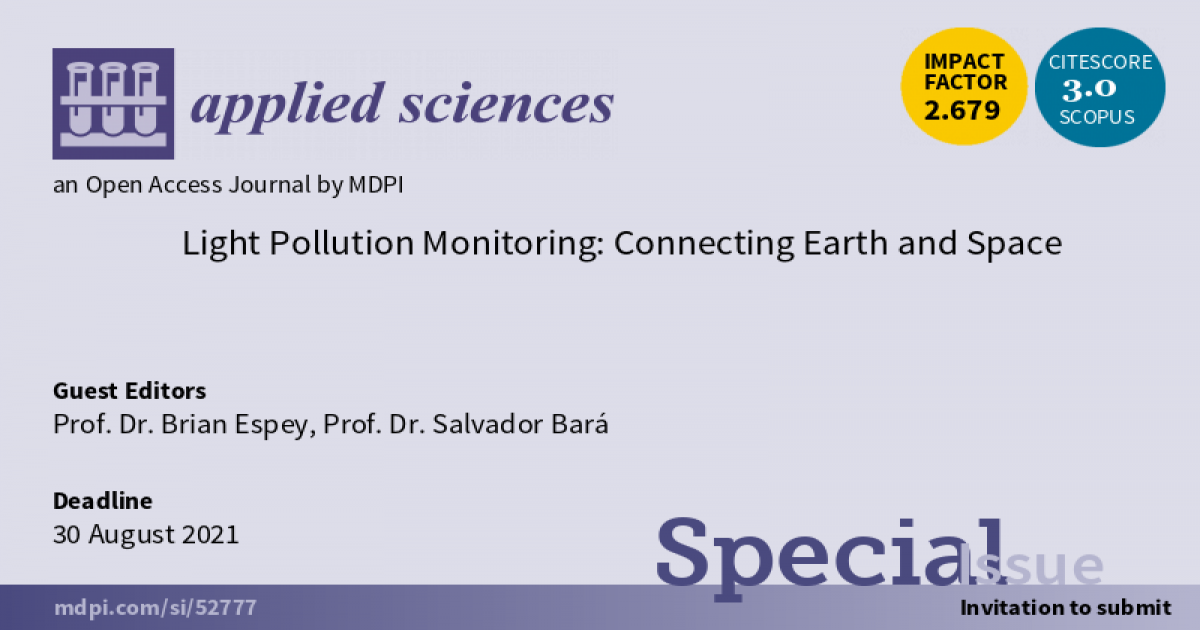Light Pollution Monitoring: Connecting Earth and Space
A special issue of Applied Sciences (ISSN 2076-3417). This special issue belongs to the section "Optics and Lasers".
Deadline for manuscript submissions: closed (30 August 2021) | Viewed by 457

Special Issue Editors
Interests: artificial light at night (ALAN); light pollution; light measurement; artificial light at night modelling; ground-based night-light measurements; satellite night-light monitoring; public outreach; dark sky activism
Special Issue Information
Dear Colleagues,
The past decade has seen a growth of interest in the topic of light at night as we become more aware of the increasing environmental light burden and the impact of light on human health and biodiversity, as well as the more obvious deleterious effect of excessive light in terms of energy waste. The launch of SUOMI NPP and subsequent spacecraft such as Luojia-1 has given the research community access to near-real-time quantifiable night-time measurements from space at a community scale of hundreds of metres, and these data have supplemented DSLR imagery from the International Space Station, which provides color information down to the tens of metres scale. Much progress has been made with the utilisation and integration of these data in the fields of local economics, industrial development and population growth, as well as for studying oil and gas production, and environmental light. The connection with human habitation and working has also enabled night light data to be used to monitor the impact of the COVID-19 pandemic and the correlation with air pollution.
In this Special Issue, we invite submissions on the impact of both space- and ground-based artificial light at night (ALAN) measurements and their implications for the wider environmental and scientific field. We particularly encourage papers which connect ground-based luminance, illuminance and photographic data with space-borne measurements to close the loop in the measurement process and thus produce an integrated picture of light at night. Survey papers and reviews are welcomed.
Prof. Dr. Brian Espey
Prof. Dr. Salvador Bará
Guest Editors
Manuscript Submission Information
Manuscripts should be submitted online at www.mdpi.com by registering and logging in to this website. Once you are registered, click here to go to the submission form. Manuscripts can be submitted until the deadline. All submissions that pass pre-check are peer-reviewed. Accepted papers will be published continuously in the journal (as soon as accepted) and will be listed together on the special issue website. Research articles, review articles as well as short communications are invited. For planned papers, a title and short abstract (about 100 words) can be sent to the Editorial Office for announcement on this website.
Submitted manuscripts should not have been published previously, nor be under consideration for publication elsewhere (except conference proceedings papers). All manuscripts are thoroughly refereed through a single-blind peer-review process. A guide for authors and other relevant information for submission of manuscripts is available on the Instructions for Authors page. Applied Sciences is an international peer-reviewed open access semimonthly journal published by MDPI.
Please visit the Instructions for Authors page before submitting a manuscript. The Article Processing Charge (APC) for publication in this open access journal is 2400 CHF (Swiss Francs). Submitted papers should be well formatted and use good English. Authors may use MDPI's English editing service prior to publication or during author revisions.
Keywords
- artificial light at night (ALAN)
- light pollution
- remote sensing
- all-sky imagery
- energy use
- environment






